Reciprocal modulation of function between the D1 and D2 dopamine receptors and the Na+,K+-ATPase
- PMID: 18984584
- PMCID: PMC2605984
- DOI: 10.1074/jbc.M805520200
Reciprocal modulation of function between the D1 and D2 dopamine receptors and the Na+,K+-ATPase
Abstract
It is well documented that dopamine can increase or decrease the activity of the Na+,K+-ATPase (NKA, sodium pump) in an organ-specific fashion. This regulation can occur, at least partially, via receptor-mediated second messenger activation and can promote NKA insertion or removal from the plasma membrane. Using co-immunoprecipitation and mass spectrometry, we now show that, in both brain and HEK293T cells, D1 and D2 dopamine receptors (DARs) can exist in a complex with the sodium pump. To determine the impact of NKA on DAR function, biological assays were conducted with NKA and DARs co-expressed in HEK293T cells. In this system, expression of NKA dramatically decreased D1 and D2 DAR densities with a concomitant functional decrease in DAR-mediated regulation of cAMP levels. Interestingly, pharmacological inhibition of endogenous or overexpressed NKA enhanced DAR function without altering receptor number or localization. Similarly, DAR function was also augmented by small interfering RNA reduction of the endogenous NKA. These data suggest that, under basal conditions, NKA negatively regulates DAR function via protein-protein interactions. In reciprocal fashion, expression of DARs decreases endogenous NKA function in the absence of dopamine, implicating DAR proteins as regulators of NKA activity. Notably, dopamine stimulation or pertussis toxin inhibition of D2 receptor signaling did not alter NKA activity, indicating that the D2-mediated decrease in NKA function is dependent upon protein-protein interactions rather than signaling molecules. This evidence for reciprocal regulation between DARs and NKA provides a novel control mechanism for both DAR signaling and cellular ion balance.
Figures





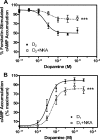
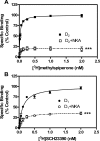
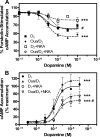


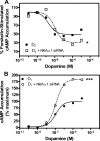


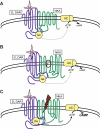
Similar articles
-
Protein kinase C mediates phosphorylation, desensitization, and trafficking of the D2 dopamine receptor.J Biol Chem. 2004 Nov 19;279(47):49533-41. doi: 10.1074/jbc.M408319200. Epub 2004 Sep 3. J Biol Chem. 2004. PMID: 15347675
-
Crosstalk between dopamine receptors and the Na⁺/K⁺-ATPase (review).Mol Med Rep. 2013 Nov;8(5):1291-9. doi: 10.3892/mmr.2013.1697. Epub 2013 Sep 19. Mol Med Rep. 2013. PMID: 24065247 Review.
-
Dopamine D2L receptors stimulate Na+/K(+)-ATPase activity in murine LTK- cells.Mol Pharmacol. 1996 Feb;49(2):373-8. Mol Pharmacol. 1996. PMID: 8632772
-
D2-like receptor-mediated inhibition of Na+-K+-ATPase activity is dependent on the opening of K+ channels.Am J Physiol Renal Physiol. 2002 Jul;283(1):F114-23. doi: 10.1152/ajprenal.00244.2001. Am J Physiol Renal Physiol. 2002. PMID: 12060593
-
A novel dopamine receptor signaling unit in brain: heterooligomers of D1 and D2 dopamine receptors.ScientificWorldJournal. 2007 Nov 2;7:58-63. doi: 10.1100/tsw.2007.223. ScientificWorldJournal. 2007. PMID: 17982577 Free PMC article. Review.
Cited by
-
Specialized Functional Diversity and Interactions of the Na,K-ATPase.Front Physiol. 2016 May 25;7:179. doi: 10.3389/fphys.2016.00179. eCollection 2016. Front Physiol. 2016. PMID: 27252653 Free PMC article. Review.
-
Dopamine receptors - IUPHAR Review 13.Br J Pharmacol. 2015 Jan;172(1):1-23. doi: 10.1111/bph.12906. Br J Pharmacol. 2015. PMID: 25671228 Free PMC article. Review.
-
Dopamine and G protein-coupled receptor kinase 4 in the kidney: role in blood pressure regulation.Biochim Biophys Acta. 2010 Dec;1802(12):1259-67. doi: 10.1016/j.bbadis.2010.02.004. Epub 2010 Feb 12. Biochim Biophys Acta. 2010. PMID: 20153824 Free PMC article. Review.
-
Na+/K+- and Mg2+-ATPases and Their Interaction with AMPA, NMDA and D2 Dopamine Receptors in an Animal Model of Febrile Seizures.Int J Mol Sci. 2022 Nov 24;23(23):14638. doi: 10.3390/ijms232314638. Int J Mol Sci. 2022. PMID: 36498965 Free PMC article.
-
Dopaminergic System in Promoting Recovery from General Anesthesia.Brain Sci. 2023 Mar 24;13(4):538. doi: 10.3390/brainsci13040538. Brain Sci. 2023. PMID: 37190503 Free PMC article. Review.
References
-
- El-Ghundi, M., O'Dowd, B. F., and George, S. R. (2007) Rev. Neurosci. 18 37-66 - PubMed
-
- Goldman-Rakic, P. S. (1998) Adv. Pharmacol. 42 707-711 - PubMed
-
- Missale, C., Nash, S. R., Robinson, S. W., Jaber, M., and Caron, M. G. (1998) Physiol. Rev. 78 189-225 - PubMed
-
- Schultz, W. (2002) Neuron 36 241-263 - PubMed
-
- Sealfon, S. C., and Olanow, C. W. (2000) Trends Neurosci. 23 S34-S40 - PubMed
Publication types
MeSH terms
Substances
Grants and funding
LinkOut - more resources
Full Text Sources
Molecular Biology Databases

